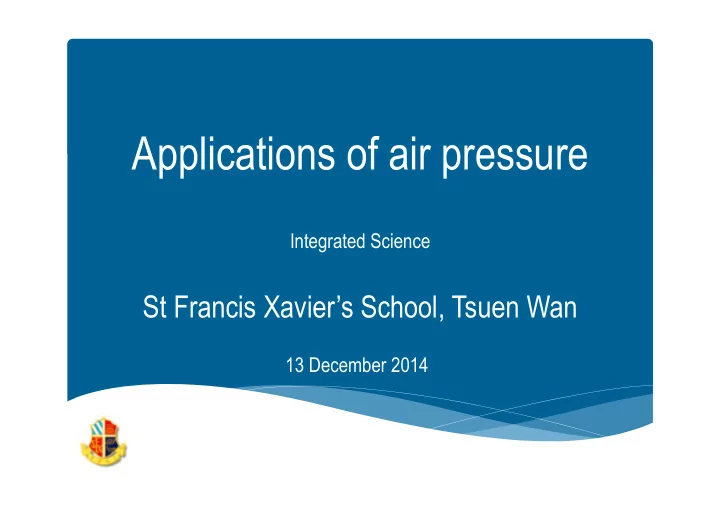

Applications of air pressure Integrated Science St Francis Xavier’s School, Tsuen Wan 13 December 2014 � �
Developing Cycles of Teaching and Learning SETTING THE CONTEXT • Working with prior knowledge: ! � – Particle theory – Concept of gas pressure – How a force is set up from gas pressure • Informing what the new knowledge is: – Explaining how gas pressure difference results in a net force, which is applied in various ways in our lives.
Suggested Cycle of Teaching and Learning EXPLAINING how a balloon in a bottle behaves Modelling and EXPLAINING Deconstruction why a drink EXPLAINING why a rubber box collapses sucker works Assessment Guided Construction EXPLAINING EXPLAINING why a vacuum why a can plastic bag gets crushed works Independent Homework Construction
Break up the content into manageable bits and make the thinking visible When we teach new knowledge, we break it up into manageable bits by asking sets of content-specific guiding questions , which construct the knowledge for the students. In other words, there is pedagogical resonance because the way that the teaching unfolds resonates with the unfolding of the knowledge. By doing this—asking the same set of knowledge-specific guiding questions repeatedly over the teaching and learning cycle—we scaffold the students’ learning.
Provide multiple ways of making meaning and a sequence that provides a macro-scaffold We provide multiple ways of making meaning such as: experiments, simulations, diagrams, videos, sequences of spoken and written guiding questions. We make sure the sequence of activities and knowledge move from the simple to the complex, the concrete to the technical and abstract—in this way, the students’ are scaffolded in both their language and their learning .
St Francis Xavier’s School, T.W. Science Learning Circle — Lesson Plan Teacher: LAM Class: 1B Venue: IS Lab (2/F) Subject: I.S. Date: 25 March 2014 Lesson plan Topic: Application of gas pressure Content objectives: 1. Students understand the size of the “force” given by the atmospheric pressure (Magdeburg Hemisphere, rubber sucker) 2. Students can apply the particle theory and their knowledge of air pressure to explain an interesting phenomenon, e.g. The inflation of a balloon in a bottle by sucking out air from the bottle. 3. Students can apply the particle theory and their knowledge of air pressure to explain the working principle of some common tools, eg: a rubber sucker, a vacuum plastic bag Language objectives : 1. Students are familiar with the technical and abstract terms used to explain gas pressure experiments. 2. Students learn the language resources needed to explain cause and effect. 3. Students can write a sequential explanation for the change in gas pressure. OBJECTIVES TEACHING FLOW REMARKS Please refer to Motivation 1. Pressure gun demonstration [ 5 min ] Modelling 1. Magdeburg Hemisphere [ 20 min ] the last page a. Video [ 2 min ] http://www.youtube.com/watch?v=9iRkPiaFmVs Modelling & deconstruction b. Demonstration [inviting Ss to be involved; 5 min] c. Detailed explanation of Magdeburg Hemisphere: 13 min, with Q&A] 2. Balloon in a bottle expt. [ 8 min] ; WS 1: Filling the keywords a. Demonstration [ 3 min], one with a hole; the other without a hole Guided construction b. Finding out the causes and effects [ 2 min] c. Group presentation (1-2 groups) [3 min] Development 3. Rubber sucker [ 9 min]; WS 2 : Sequencing the explanation [ ~ 53 min ] Guided construction a. Student experiment [ 3 min ] b. Sequencing the causes and effects (Group discussion) [ 3 min] c. Group presentation (1-2 groups) [3 min] (with support) 4. Vacuum Plastic bag [ 16 min ]; WS 3 : Writing their own explanation a. Demonstration or video show [ 1 min ] b. Finding the causes and effects (Group discussion) [ 3 min] Independent construction c. Group presentation (1-2 groups) [ 12 min ] (without support, A3 sheet per gp) 1. Guided construction 1. Writing an explanation for the working principle of a rubber sucker. Consolidation 2. Independent construction 2. Writing an explanation for the working principle of a vacuum plastic bag. [ ~20 min] Independent construction Passage writing for the working principle of the pressure gun. Homework Show the diagram of the internal structure of the pressure gun [ 2 min]
Language objectives 1. Students are familiar with the technical and abstract terms used to explain gas pressure experiments. 2. Students learn the language resources needed to explain cause and effect. 3. Students can write a sequential explanation for the change in gas pressure.
Motivation Visible language Example 1: Magdeburg Hemispheres Questioning based on a set of guiding questions Resonance and consolidation Students’ work
Sequencing using the guiding questions— rubber sucker example
Guiding questions Sequencing using the guiding questions
Students’)work
Students’ work
Students’ work
Sequencing using the guiding questions
Sequencing using the guiding questions
More everyday language resources at the start !!!!!!suck!away!air )fewer)air)particles � Because � )fewer)air)particles !lower!air!pressure � !lower!air!pressure !air!pressure!difference Because � � � !air!pressure!difference !a!net!force!is!set!up Because � � � balloon!in!a!bo/le!inflates! Because � !a!net!force!is!set!up � can!collapses! plas4c!bag!deflates! rubber!sucker!s4cks!to!the!wall �
Individual work Group work Independent Construction 2
Students’ work
Students’ work
Assessment
Thank you Happy SFXS teachers and students
Recommend
More recommend